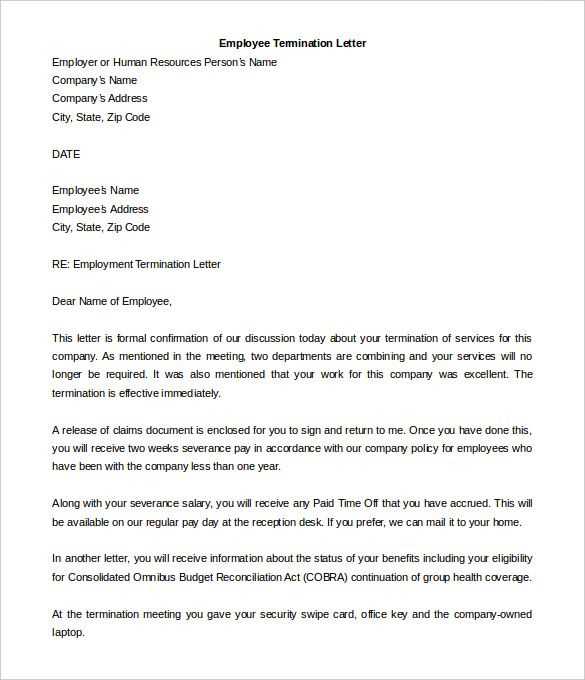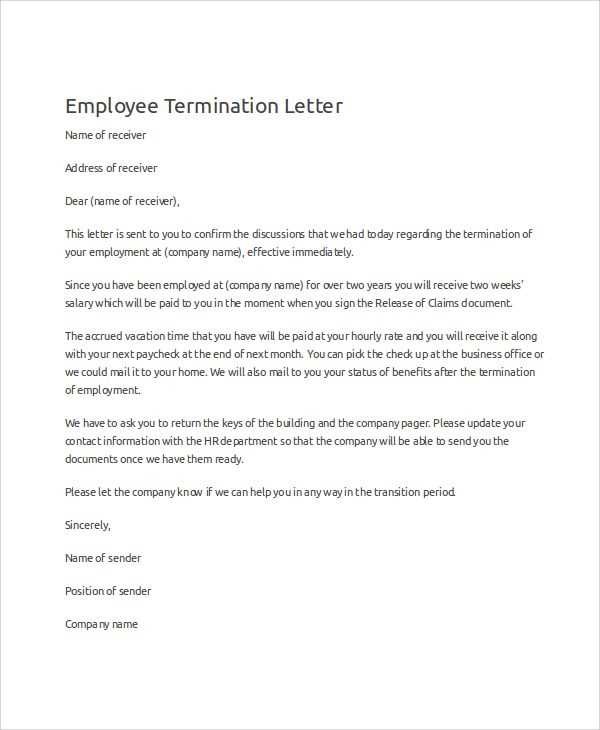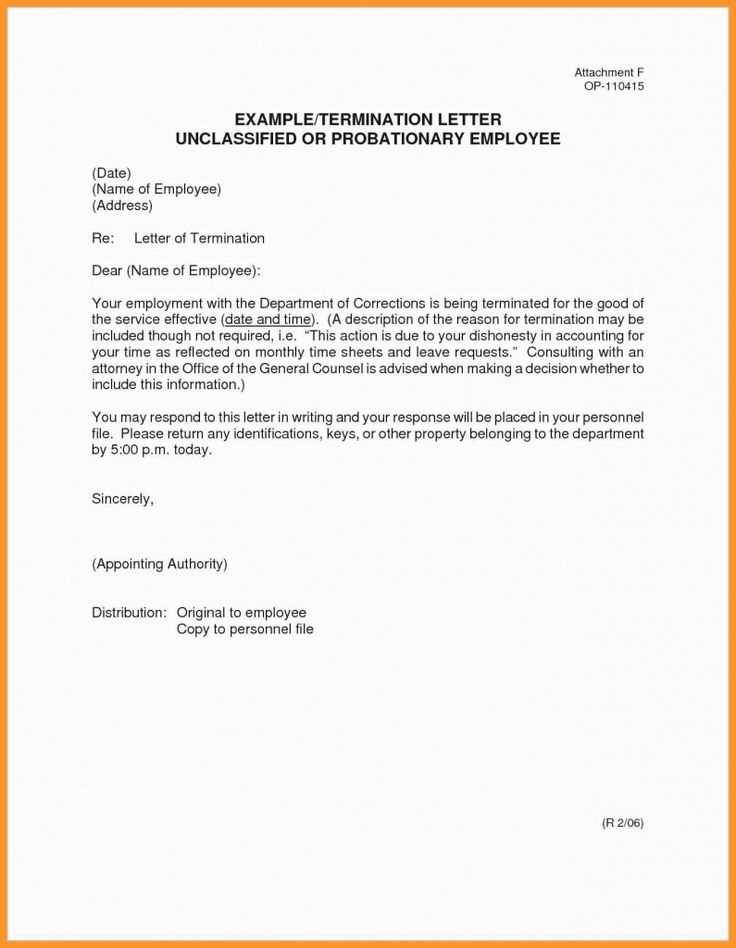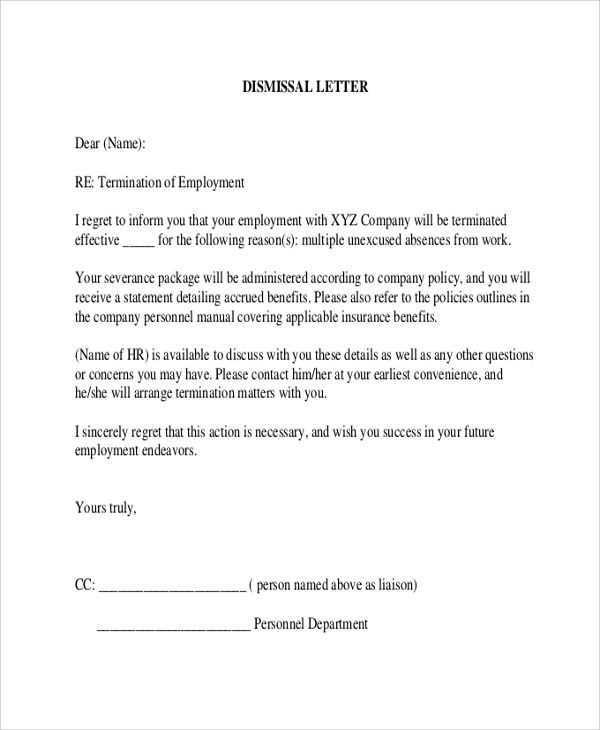Employee Letter of Termination Template for Employers

When ending a professional relationship, clear communication is essential. A formal document outlining the separation process ensures that both parties are informed and prepared for the transition. It also helps maintain professionalism and protects the organization from potential misunderstandings or legal issues.
Crafting this kind of communication requires careful attention to tone, language, and legal considerations. By following a structured approach, employers can ensure that the message is respectful, concise, and legally sound. The goal is to address the necessary points without unnecessary detail, making the process smoother for both the company and the individual involved.
Being thoughtful and organized in this process demonstrates professionalism, and using a structured format can simplify this task. It is important to consider all relevant details while respecting the privacy of the person being let go. In this guide, we will discuss the key aspects to include in such a document and provide tips on creating a comprehensive, effective notice.
Understanding the Importance of Termination Letters
Formal communication when ending a professional relationship plays a crucial role in ensuring clarity and avoiding confusion. It serves as an official record of the decision, providing both the organization and the individual with an understanding of the circumstances surrounding the separation. This process is essential in maintaining a respectful and transparent environment.
Without such documentation, misunderstandings may arise, leading to potential legal issues or disputes. A well-structured communication not only outlines the reasons for the separation but also ensures that all relevant policies and procedures are followed. This transparency helps protect both the employer and the departing individual.
Benefits of Clear Communication in Separation
| Benefit | Description |
|---|---|
| Clarity | Clearly outlines the reason for separation and the expectations moving forward. |
| Legal Protection | Helps prevent future legal disputes by documenting the decision properly. |
| Professionalism | Maintains a respectful and professional tone, protecting the company’s reputation. |
| Record Keeping | Provides a formal record for future reference in case of inquiries or audits. |
Reducing Misunderstandings and Disputes
By formally outlining the details of the departure, both parties can avoid confusion regarding the terms of the separation. This not only benefits the organization by providing a clear record but also assists the departing individual in understanding their rights and responsibilities. Addressing all necessary points, including any final payments, return of company property, and other contractual obligations, further minimizes the risk of future disagreements.
Essential Information to Include in the Document
When drafting a formal notice regarding the end of a professional relationship, it is important to include several key details to ensure that both parties are well-informed. A complete and thorough document can help avoid confusion and potential legal complications, providing a clear record of the separation process.
There are several essential elements that should be included to ensure the notice is comprehensive and legally sound:
- Reason for the Separation: Clearly state the cause, whether it’s performance-related, company restructuring, or another factor.
- Effective Date: Specify the date when the separation becomes official, allowing both parties to prepare accordingly.
- Final Compensation: Outline any final payments, including unused vacation time or severance packages, if applicable.
- Return of Company Property: List any items that need to be returned, such as keys, equipment, or documents.
- Exit Procedures: Detail the steps involved in the exit process, including any necessary meetings or forms to complete.
- Contact Information: Provide a contact point for future inquiries or concerns, ensuring the departing individual can reach the organization if needed.
Including these critical points in the document will help to create a comprehensive notice that is clear, professional, and effective. It not only ensures transparency but also protects the interests of both the company and the individual moving forward.
Crafting a Clear and Respectful Notice

When communicating the end of a professional relationship, it is essential to maintain a tone that is both clear and respectful. A well-written document should ensure that the message is conveyed without confusion while also preserving the dignity of the individual involved. Striking the right balance between clarity and respect helps to minimize negative feelings and prevent misunderstandings.
To achieve this, the document should be carefully structured to focus on the facts while using a considerate and professional tone. Below are several guidelines for crafting such a message:
Key Principles for Clarity and Respect
- Be Direct Yet Tactful: Clearly communicate the decision while being mindful of the language you use to avoid unnecessary hurt or embarrassment.
- Maintain Professionalism: Keep the tone formal and neutral, ensuring the message reflects the seriousness of the situation without being overly harsh.
- Avoid Negative Language: Focus on the facts and the process rather than using negative or accusatory terms that may provoke defensiveness.
- Offer Support: When appropriate, provide information about potential assistance or future steps the individual can take, such as resources for job placement or an opportunity to discuss the decision.
Ensuring Respect Throughout the Process
Throughout the communication, it is important to focus on the individual’s contributions to the organization and acknowledge any positive aspects of their time with the company. This helps maintain goodwill and leaves the door open for future professional interactions. Additionally, providing the individual with a chance to ask questions or seek clarification ensures transparency and reduces the likelihood of resentment.
Legal Requirements for Employee Termination

When ending a professional relationship, it is essential for an organization to follow specific legal guidelines to ensure the process is compliant with relevant labor laws. Failing to adhere to these legal requirements can lead to disputes, potential lawsuits, or damage to the company’s reputation. Properly managing these aspects protects both the employer and the individual involved.
These legal obligations can vary by jurisdiction, but there are common elements that should be considered in every case. Below are some key legal aspects to be aware of when drafting formal documentation related to separation.
Compliance with Labor Laws
- Notice Period: Depending on the terms of the contract or local laws, the individual may be entitled to a notice period or compensation in lieu of notice. Failing to comply with this requirement could result in legal action.
- Non-Discriminatory Process: Ensure that the decision to end the professional relationship is not based on unlawful discrimination, such as race, gender, age, or disability.
- Severance and Benefits: Check if there are any severance packages or other benefits owed to the individual upon separation, as stipulated by contract or law.
- Final Payments: It is important to settle any outstanding wages, unused vacation time, or other accrued benefits as part of the formal process.
Documenting the Process

Keeping accurate and detailed records of the separation process is crucial for compliance. These documents can serve as evidence in case of legal disputes or if the decision is questioned at a later time. Additionally, maintaining confidentiality and handling sensitive information properly is important to avoid violating privacy rights.
Avoiding Common Mistakes in Letters
When drafting official notices regarding the end of a professional relationship, it is essential to avoid certain pitfalls that can undermine the clarity or effectiveness of the communication. Common mistakes, such as vague language or missing key details, can lead to confusion and potentially even legal issues. By being aware of these errors, you can ensure that the document is professional, clear, and legally sound.
Below are several common mistakes to avoid when preparing such formal communication:
- Being Too Vague: Avoid using unclear language. Be specific about the reasons for the separation and the date it becomes effective.
- Using Negative or Harsh Language: It is important to remain respectful and professional, even if the separation is due to performance issues or misconduct. Negative language can escalate the situation unnecessarily.
- Failing to Address Legal Requirements: Ensure that all necessary legal aspects, such as notice periods, severance pay, and benefits, are clearly addressed to avoid potential disputes.
- Omitting Important Details: Key information such as return of company property, final compensation, or contact details should never be overlooked. These are crucial for the clarity and completeness of the document.
- Not Offering Support or Resources: Whenever possible, provide information about available support, such as job placement services or other assistance, to help the individual transition smoothly.
By being mindful of these common mistakes, you can ensure that the message is delivered in a way that is both professional and clear, reducing the likelihood of future complications.
Delivering the Termination Letter Effectively
How the official notice is presented plays a significant role in the process of ending a professional relationship. The way this communication is delivered can impact the individual’s response, as well as their future relationship with the organization. It is crucial to approach this step with sensitivity and professionalism to ensure that the message is received in the right way.
The method of delivery should be thoughtful and respectful. Ensuring privacy and offering the individual a chance to process the information are key factors in minimizing distress. Below are some important considerations to keep in mind when delivering such a message:
- Choose the Right Timing: Ideally, the communication should be given at a time when the individual can process the information privately. Avoid delivering it during a busy workday or in a public setting.
- Face-to-Face Communication: Whenever possible, deliver the message in person. This helps convey respect and allows for immediate questions or clarification. If an in-person meeting is not feasible, a video call or phone call is a more personal approach than email.
- Remain Calm and Supportive: Maintain a composed and empathetic tone when delivering the news. Acknowledge the individual’s contributions to the organization and offer any support or resources available to assist with the transition.
- Provide a Written Record: Even if the decision is communicated in person, it is important to follow up with a formal document outlining the key points discussed. This serves as a record for both parties.
- Allow Time for Questions: Give the individual an opportunity to ask questions or seek clarification about the next steps. This can help reduce uncertainty and foster a more respectful environment.
By considering these factors, the delivery of the official notice can be handled with care, minimizing potential negative reactions and maintaining professionalism throughout the process.